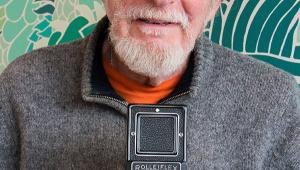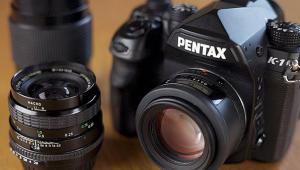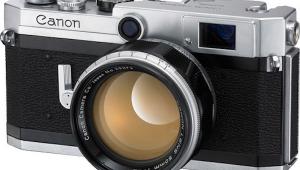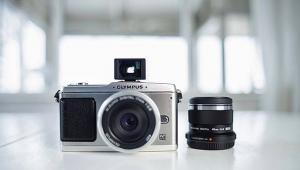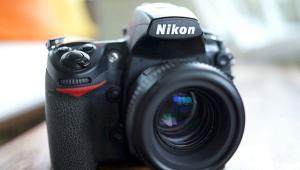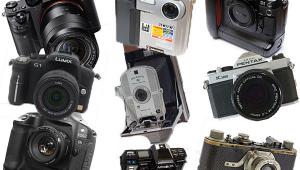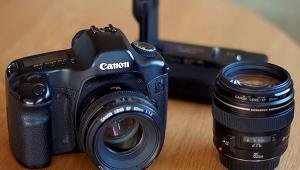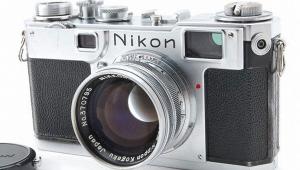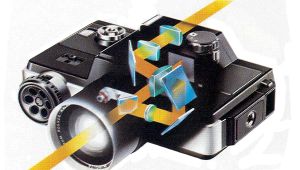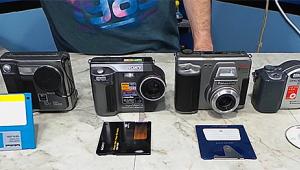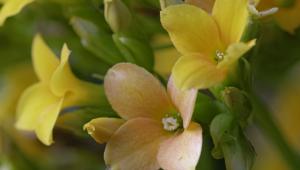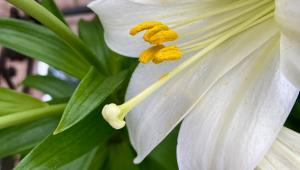The Diax Family: A Lineup Of Versatile 35mm Cameras
In the days before the 35mm Single Lens Reflex (SLR) rose to prominence, the 35mm viewfinder camera reigned supreme. Unlike the reflex viewing system of the SLR, this camera type used a separate optical viewfinder with a slightly different view to that of the lens. Some featured built-in coupled rangefinders to aid accurate focusing, and many stood at the center of versatile systems of lenses and accessories.

Names like Leica and Contax stood at the top of the tree. But for those who wanted quality at a lower price, there were cameras like the Diax. The Diax was made by Walter Voss, who moved quickly after the end of World War II to again establish Germany on the map for quality cameras. He registered the Diax name in 1945 and had a camera on the market by 1947.
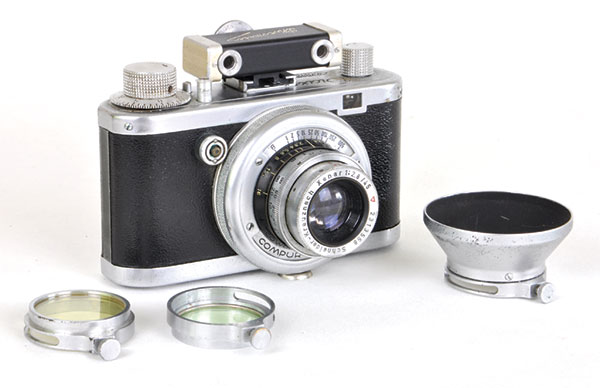
All Photos © John Wade

Cameras And Viewfinders
The first Diax was a simple 35mm model with a fixed Axinon 4cm f/3.5 lens that focused from 1 meter to infinity and a shutter offering speeds of 1 second to 1/500 sec. It had no built-in rangefinder, but a separate detachable one called the Photometer—actually the first product produced by Voss—was provided, along with a lens hood and range of filters that slipped over the lens, secured by a tiny screw. Each incorporated a slit to view aperture settings on the lens which would otherwise have been hidden when a hood or filter was fitted.
Several variations were made, using different lenses, and flash sync was added from 1949. A new version launched in 1951, called the Diax II, added a coupled rangefinder. In 1953, a final variation on the very first design was produced and called the Diaxette.
But the cameras that really put Diax on the map began with the launch, in 1952, of the Diax Ia. It lacked a rangefinder, but offered a range of interchangeable Schneider and Isco lenses with focal lengths from 35mm wide angle to 135mm telephoto.
Whereas most lenses used a male thread that screwed into a female thread on the camera body, the Diax reversed the idea with a male thread around the circumference of a ring that circled the body’s shutter mechanism. The lens slipped over this and a ring to the rear was rotated to hold it in place.



Accessory Finders
Because this style of camera lacked the reflex viewing system of the SLR, a method was needed to show the different fields of view for each of the accessory lenses. Many non-reflex cameras got around this by introducing masks into the viewfinder—the longer the lens, the smaller the mask. The Diax took a more unusual approach.
Unlike other cameras, the Diax Ia had three viewfinders. On the back of the body there were eyepieces, marked 45-50, 35, and 90, the figures referring to lens focal lengths. To help differentiate the viewfinders, two were tinted. The 45-50 viewfinder was clear, the 35 one had a blue tint, and the 90mm was yellow.
Separate viewfinders to fit the camera’s accessory shoe were also made for the different focal lengths, each with parallax adjustment by way of a bright frame that moved up and down according to a focusing adjustment on the viewfinder. The best accessory viewfinder was an adjustable one, marked with the Diax name, but built by Steinheil. Turning a ring on the front slid a series of lenses into position to give views for 35mm, 85-90mm, and 135mm focal lengths. A lever on the base tipped the viewfinder backward and forward to compensate for parallax.
The Diax IIa was launched in 1954. It was similar to the Ia, but with only two viewfinders for 50mm and 85-90mm lenses. The 35mm viewfinder was sacrificed so that a rangefinder could be built into the 50mm eyepiece.
The same year saw the very brief appearance of the Diax Standard, similar to the first Diaxes, but able to accept interchangeable lenses from the Ia and IIa models. Serial numbers indicate that 100 cameras were made to be sold exclusively in Australia and New Zealand, probably to test the market. Today, a mere 33 have been accounted for.
In 1956, modified versions of the Diax Ia and IIa were launched, with redesigned top plates and lever winds for film advance in place of knobs on the two previous cameras. They were called the Ib and IIb.



Other Accessories
Every lens in the Diax Ia, Ib, IIa, and IIb range had a filter thread of 40.5mm, so all the filters were suitable for all the lenses. Each was sold in its own transparent plastic case with a hinged lid. The colors and types available were light yellow, medium yellow, yellow-green, orange, red, blue, UV, and skylight.
Diax lens hoods also had the same sized threads to screw into the filter threads of each lens.
Voss didn’t make an exposure meter for the cameras, but Diax advertisements of the time recommended fitting a Metraphot 2, made by Metrawatt in 1954, into the accessory shoe.
Close-Up Equipment
It wasn’t unusual for viewfinder cameras to be equipped with close-up lenses, and the Diax had two in its system. The problem with traditional lenses of this type was that they converted only the lens for close-up photography, without affecting the viewfinder or rangefinder. The Diax solved that by offering two Proximeters, each containing two lenses. A circular close-up lens fitted to the camera lens via a special adapter ring, and attached above this was a rectangular lens that stood in front of the rangefinder windows. This deflected light, converting the rangefinder for use down to the close-focusing limit of 10”, at the same time correcting parallax.
The Diax system offered another unusual accessory for close-up photography, in the shape of an expanding metal rule, coiled into a circular container that screwed into the camera’s tripod bush. Another bush on the base of the rule screwed onto the tripod. Extending the rule up to 1 meter (39”) accurately measured the camera-to-subject distance.
The Voss company also offered one more close-up accessory, suitable for the Diax and other cameras. The Reprox 12 took the form of a flat table with a built-in close-up lens in its center, over which the camera lens was fitted, using two adjustable clamps. Four legs were attached to the corners of the table, lining it up to shoot any flat subject.
Another unusual accessory came from the German company Sperling, who made a bellows attachment that incorporated a reflex system with adapters for various cameras, including the Diax. When fitted, it turned the camera into a single lens reflex for close-up photography.


The Last Diaxes
In 1957, the Diax L-1 was launched. Its design was a little different from any of the others, with a non-interchangeable lens, flash sync, lever wind, shutter release on the front of the body, and—for the first time—a built-in selenium cell exposure meter. It wasn’t a great success and today is rare. The Diax factory closed for business in 1957.

© Holger Schult
Approximate Values
Original Diax, $60 to $90; Diax Ia/Ib, $150; Diax IIa/IIb, $150 to $170; Diax L-1, $210; Diax Standard, one recorded sale (in Australia) of $1200. Accessory lenses, according to focal length, $30 to $90.
- Log in or register to post comments


